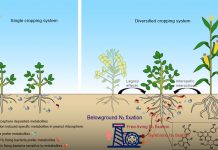He LL Liu Y Zhao J Bi YC Zhao X Wang SQ Xing GX. Comparison of straw-biochar-mediated changes in nitrification and ammonia oxidizers in agricultural oxisols and cambosols. Biology and Fertility of Soils 2015 DOI: 10.1007-s00374-015-1059-3
Abstract
The responses of nitrification on intensively managed agricultural soils following long-term biochar (BC) amendment are poorly understood. The nitrification potential abundance and composition of ammonia-oxidizing archaea (AOA) and ammonia-oxidizing bacteria (AOB) in acidic oxisols and alkaline cambosols following a 3-year BC treatment were investigated using 42-day aerobic incubation quantitative polymerase chain reaction (qPCR) and clone library approach respectively. Fresh soils were collected from a wheat-millet rotated pot trial in which 0 (control) 2.25 and 22.5 Mg ha−1 rice straw BCs were added for six consecutive crop seasons. The 22.5 Mg ha−1 BC (BC22.5) treatment enhanced nitrification in oxisols and even altered nitrification pattern from zero-order to first-order reaction model. AOA and AOB gene copies in the BC22.5 treatment were 9.55 and 22.0 times respectively compared with those in the BC0 treatment. The relative abundance of operational taxonomic units (OTUs) in AOA group 1.1a changed due to BC application and that of OTU-20 was high in group 1.1b-related under the BC22.5 treatment. AOB community composition shifted toward Nitrosospira cluster 3 and 3-related group under the BC22.5 treatment. Basal nitrification was already high in cambosols and BC had minimal effect on nitrification or AOA-AOB abundance. However the BC22.5 treatment increased the relative abundance of OTU-9 in Nitrosospira cluster 3 group and that of OTU-13 and OTU-16 in Nitrosospira cluster 3-related groups both being AOB. The BC amendment had minimal effect on ammonia oxidizer composition in cambosols but influenced ammonia oxidizer composition and stimulated nitrification activity in oxisols.







